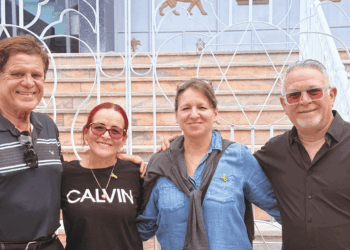By MICHAEL A. APPLEMAN, Ph.D
Improved relations with Cuba are escalating. The Minnesota Orchestra has been to Cuba. President Barack Obama arrived on March 20, the Rolling Stones were set to perform March 25, and American baseball arrived earlier in the month. However, the embargo has yet to be lifted by Congress. The Jewish community continues to be in need — which is still dire.
Templo Beth Shalom, or Beth Shalom Temple, is the largest Jewish congregation in Cuba. I interviewed its president, 74-year-old Adela Dworin, last month. As she sat at her desk in the library, things were bustling, dynamic and vibrant.
While talking to me, she welcomed a cantor from Canada, received more than 400 new, beautiful Hebrew-Spanish prayer books from Chile, and directed her shul staff. We spoke in English and, in part, Spanish:
Appleman: Are you excited about your new 500 siddurim, Sidur Beemunah Shleimah, published in Chile?
Dworin: Yes. These 500 siddurim are not only in Hebrew and Spanish, but have phonetic translations. This helps the many Cubans who cannot read Hebrew. These books just came from Chile, paid for by the Joint (the American Joint Distribution Committee).

A: How long have you worked at Beth Shalom?
D: I have been working for the Jewish community since 1970, for over 40 years. I started as a volunteer. But when Dr. José Miller, the former president, died in 2006, I became president.
A: When did the first Jews come to Cuba?
D: In 1492, Luis de Torres, who was employed by Christopher Columbus, was a Marrano (convert who continued to practice Judaism). Since Cuba was a Spanish colony, it was not spared the Inquisition.
A: When did Jews become prominent in Cuba?
D: Cuba became a Republic in 1902. In 1906, American Jews came to Cuba from the United States and became successful businessmen in tobacco, railways and sugar. They started the first synagogue, which was Reform, The United Hebrew Congregation.
A: How many Jews live in Cuba today?
D: 1,200, and 85 percent live in Havana — and most have intermarried. There were about 15,000 Jews before the Revolution in 1959. Most of the Jews escaped to the United States, Central and South America, as well as Israel.
A: What is the history of Jewish immigration to Cuba?
D: In the 1920s, a big wave, about 8,000 Jews, came to Cuba from Europe, including Poland, Hungary and Romania. In 1942, 4,000 Jews arrived from Belgium.
A: What impact did the Revolution of 1959 have on the Jews?
D: Many of the Jews became very wealthy in the 1950s in the shmata business, retail department stores and other successful businesses. The children became professionals. But, after the revolution, Castro confiscated their private businesses and seized their bank accounts. About 90 percent of the Jews left for the United States, Israel, Mexico and Venezuela. Those remaining in Cuba were prohibited from speaking about or practicing religion. We did not have marriages or Bar Mitzvas. Intermarriage was prevalent.
A: What changed in 1991?
D: In 1991, Castro amended the Constitution after a visit from the Pope. The practice of religion was no longer prohibited, it was allowed. The board of the synagogue, through Dr. José Miller, approached the JDC in New York for help in revitalizing the community, most of which had intermarried. The Joint started sending rabbis from Mexico and Argentina.
A: When did you meet Fidel Casto? (This question was prompted by a photograph of Adela and Fidel on the synagogue wall.)

D: I met Fidel in 1998 when there was a meeting with all the leaders of the different religions at the presidential palace. There were over 100 guests, Christians and Jews. Fidel said, “From now on, Christmas will be celebrated as a national holiday. You can practice religion in your communities.” I invited him to the synagogue for a Hanuka party. He celebrated with us. He was kind to the Jewish community and spoke of Jewish history.
A: When did you meet Raúl Castro? (Also prompted by a photograph.)
D: Raúl has been president since 2006. I met him in the Revolutionary Square at the José Marti Building. I also invited him to a Hanuka party. He came and lit candles… He gave a speech … He was delighted to see such a small vibrant community.
A: What other famous people have been to Beth Shalom?
D: Steven Spielberg in 2002 (there is a picture of Dworin and Spielberg on the shul wall). Spielberg said, “I never believed in miracles until I saw the Jewish community in Cuba.”
A: What changes have you seen since Obama opened relations with Cuba on Dec. 14, 2014? (I coincidentally was in Cuba at that time and heard Raúl Castro on television make the announcement of improved relations.)
D: We receive a lot more Jewish visitors. But we still are a tiny community struggling to maintain our Judaism. The (Jewish) missions help. We need more help from the world. (The per capita income of all Cubans, including Jews, is $25 USD per month.)
A: What challenges do you face?
D: It is hard to prevent the youngsters and adults from leaving Cuba. They all want to go to the United States or Israel.
A: What has Obama done for the Jewish community?
D: Obama has done more for Cuban relations than any other president. We are hoping the embargo will be lifted. The Cuban Jews need help and many are suffering deeply.
***
Michael Appleman, Ph.D., has been licensed to conduct humanitarian work in Cuba for the last 10 years. He has raised funds for Jewish causes in Minneapolis through the sale of Cuban art. He is married to Mickey Appleman and has three children, Alaina, Joshua and Danielle.
(American Jewish World, 3.25.16)



















